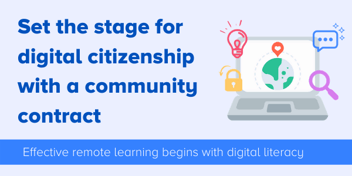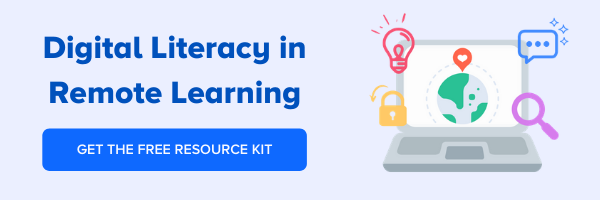Set the stage for digital citizenship with a community contract
Teachers are scrambling to respond to the sudden push towards remote learning, and technology is helping bridge the gap left by the classroom. But with all the live conferencing, increased screentime, and new learning apps arises another challenge for schools to solve: how to make sure students safely and effectively engage with these tools.
Digital citizenship has become critical to the curriculum
A 2018 study by the Pew Research Center found that 95% of teenagers surveyed had a smartphone, and 45% were online “almost constantly.” These digital natives are plugged into a continuous stream of social media notifications and targeted advertising while being subject to harassment and cyberbullying, as well as data collection from major corporations.
Digital citizenship aims to empower students to carry values of dignity, respect, and safety from physical society into the digital space. Privacy concerns, cyberbullying, screentime limits, altered or fake media, and oversharing are all issues that come with the territory of working with digital technology.
Do your students communicate respectfully with their peers in a chat? Can they evaluate the credibility of an article shared on social media? Do they actively monitor their account and privacy settings to protect their data? What strategies do they employ when dealing with harassment?
These behaviors don’t happen in a vacuum. They’re skills, and schools are increasingly recognizing the importance of teaching them. When students understand both how to use technology and how to interact with the digital world, they become empowered citizens.
Digital citizenship programs have been a slow but growing trend nationwide. Now as teachers and students are connecting exclusively over digital mediums, the importance of these programs is no longer so abstract. Recent privacy breaches and behavior concerns have shed light on the risks of not establishing standards of digital engagement.
What teachers can do right now is collaborate with their students on an agreement for their virtual classroom.
Lay the foundation with a community contract
Teaching in a virtual classroom or supporting students from a distance requires the first step as the first day of school: setting out some community guidelines.
Facilitate a discussion in your next lesson. Ask students to reflect on positive classroom or learning communities they have been part of and what qualities made those environments an enjoyable place to learn. What classes or teachers did they love and why? How did they get along with their peers?
Next, analyze with your students the ways that you all will engage with each other during remote learning. Email, chat, video conferencing, and threaded discussions are a likely few. Ask students to brainstorm a set of student expectations and teacher expectations. This is the opportunity to speak with students about privacy concerns and the importance of not sharing links or codes with the public, and about protections on their data and identity.
Take notes during the discussion or collect their responses and create a community contract for students to sign, just like the classroom rules on the first day of school.
Looking for digital citizenship resources?
Common Sense Education and PBS Learning Media both have great resources if you want to dive deep with your students on digital citizenship.
Also check out our digital citizenship learning kit with free digital literacy worksheets and videos from one of our digital citizenship collections on Boclips for Teachers. Easily share in Google Classroom to get your classroom discussion started.
Bree Fabig
Bree has experience in multicultural and multilingual classrooms in the US, Japan, and Nepal and has taught primary, ESL, SAT prep, and secondary language arts.
- #Classroom
- #Video in Digital Learning
- #Educational Videos
- #Tips for Using Video
- #Video Content Partners
- #Boclips for Publishers
- #Issues in Education
- #Educational Videos by Subject Area
- #News and Announcements
- #Events & Holidays
- #Video and Teaching Tools
- #Teaching Methodologies
- #Education Videos
- #Video and Digital Literacy
- #Short Educational Videos
- #Instructional Design
- #Multimodal Learning
- #Video and Student Safety
- #Accessibility in Education
-3.png?width=390&height=223&name=Untitled%20design%20(2)-3.png)


.png?width=1152&height=660&name=Copy%20of%20Untitled%20Design%20(1).png)

.jpg?width=570&name=teenage-students-using-digital-devices-on-college-P25PJWY%20(1).jpg)



